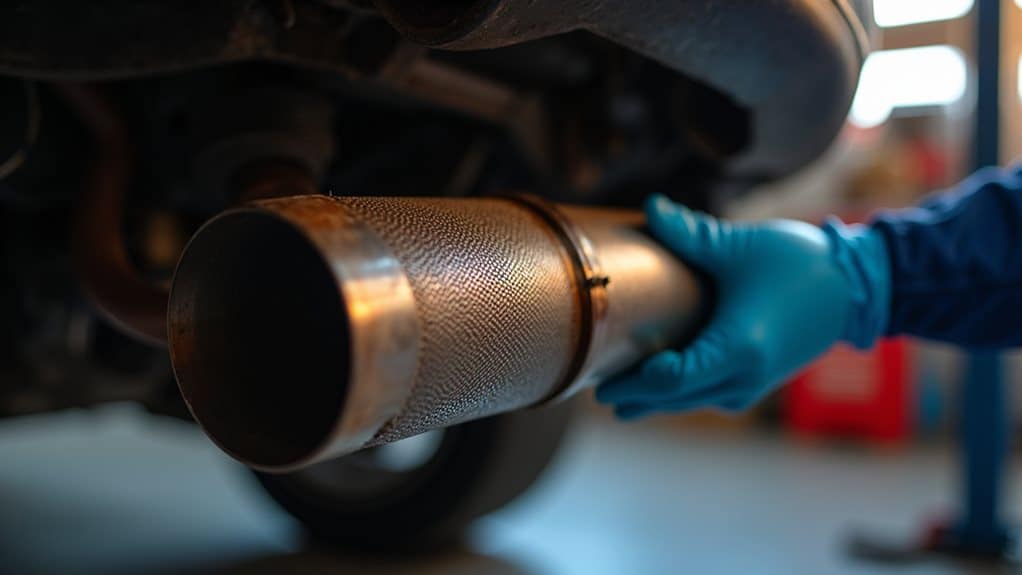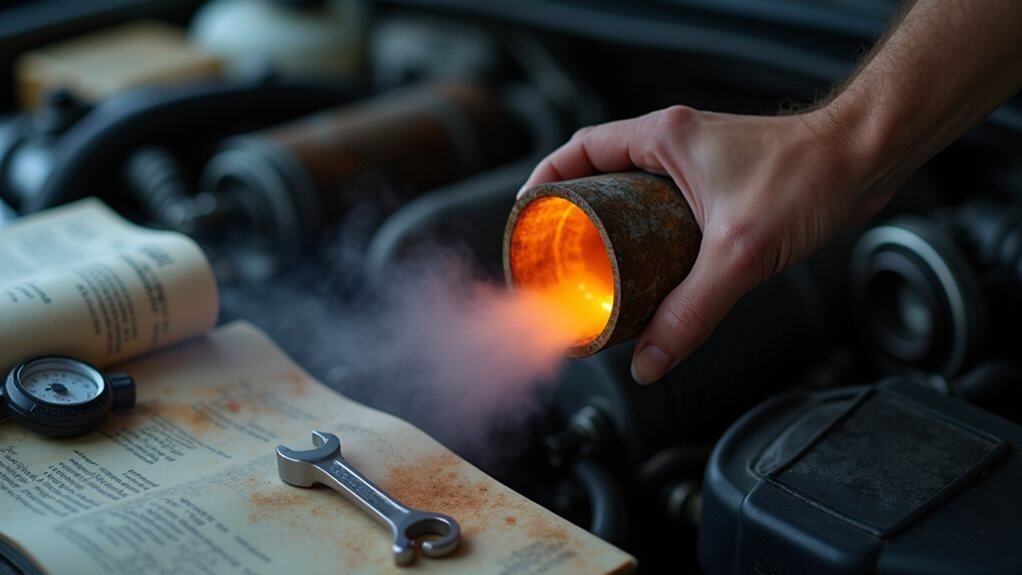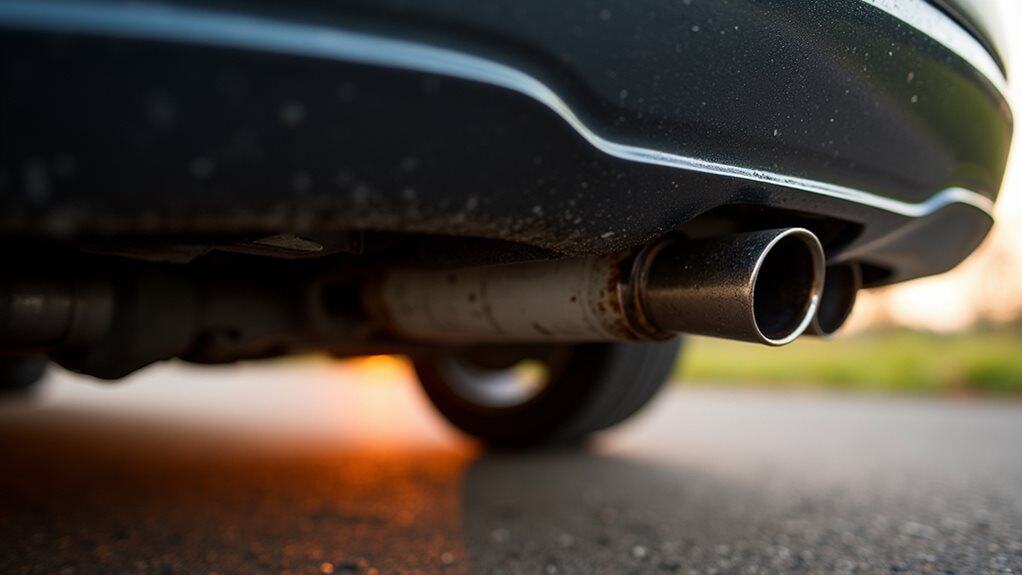You’ll likely notice a temporary chemical or “burning” smell from a new catalytic converter as factory oils, coatings and adhesives vaporize under high exhaust temperatures; these VOCs and machine oils off-gas during initial heat cycles and usually fade after several drives, especially longer highway runs. Persistent rotten-egg (sulfur), fuel, or burning-plastic odors, performance loss, rattling, or Check Engine lights suggest a problem needing inspection and diagnostics, and below you’ll find how to check and what to expect next.
Quick Tips
- New catalytic converters often emit temporary burning or chemical odors as manufacturing oils, coatings, and adhesives off-gas during initial heat cycles.
- Typical off-gassing odors usually fade after multiple drives, commonly within 2–4 weeks, but can last longer with many short trips.
- A persistent rotten-egg (sulfur) smell beyond about three to four weeks suggests the converter isn’t converting H2S properly and needs inspection.
- Strong fuel, sweet (coolant), or burning-oil smells indicate unrelated leaks, fuel-system issues, or overheating that require immediate attention.
- If odors persist with reduced performance, check-engine lights, rattling, or poor fuel economy, get OBD-II diagnostics and a professional inspection.
Why New Catalytic Converters Can Smell

Because new catalytic converters come straight from manufacturing and storage, they often carry residual oils, coatings, and adhesives that will vaporize when heated and produce noticeable odors; these substances are applied to protect parts during production and shipping and are burned off during initial use, aided by converter temperatures that can reach around 800°F. Regular maintenance and inspection of related components like the battery, alternator, and wiring can help ensure overall vehicle electrical systems remain stable during this break-in period and prevent unrelated electrical failures.
You’ll notice temporary burning or chemical smells as coatings off-gas, fading after several heat cycles.
Burning/plastic smell may also come from nearby engine oil or labels on parts burning off during the converter’s initial high-temperature operation.
Common Odors You Might Notice
Cars give off a surprising range of smells from the exhaust and engine bay, and knowing what each odor means helps you diagnose problems sooner.
Sulfur/rotten egg often signals a failing catalytic converter or fuel system stress.
Burning oil/fluid points to leaks or overheating.
Sweet syrup indicates coolant leaks or head gasket issues. Blown head gasket can introduce combustion gases into the cooling system and produce sweet-smelling steam.
Musty odors mean trapped moisture; gasoline smells require immediate attention. Failing catalytic converters often produce a strong rotten-egg odor because they can no longer convert sulfur compounds into harmless gases.
How Long Smells Typically Last

You’ll often notice different exhaust smells after reading about common odors, and the next question is how long those smells should last.
New catalytic converters usually smell for 2–4 weeks as manufacturing residues burn off at high temperature; short drives slow this.
Persistent sulfur beyond about three to four weeks, or smells with poor performance or warning lights, needs inspection.
A severely clogged converter can also cause symptoms like reduced vehicle power and should be diagnosed promptly.
When a Sulfur Smell Signals a Problem
If you notice a persistent rotten-egg sulfur odor coming from the exhaust, it often means the catalytic converter isn’t converting hydrogen sulfide gas properly and you should investigate further.
A lit Check Engine light alongside the smell usually points to stored diagnostic trouble codes for the converter or related sensors, so scan the vehicle’s OBD-II system to see which component is failing.
Also watch for reduced fuel economy, because a rich fuel mixture or malfunctioning injectors that waste fuel can increase H2S production and accelerate converter damage, often requiring sensor tests, fuel system inspection, or converter replacement.
Exhaust leaks, especially those occurring before the upstream O2 sensor, can disrupt the air/fuel ratio and contribute to converter problems by causing the engine to run lean or rich.
Persistent Sulfur Odor
Noticing a persistent rotten-egg smell coming from your exhaust usually means hydrogen sulfide (H2S) from fuel is getting through the catalytic converter instead of being converted to odorless sulfur dioxide, and that’s a clear sign the converter or the engine/fuel system needs attention.
Check for a clogged or failing converter, rich running (over-fueling), faulty injectors or pressure regulator, and poor fuel quality.
Check Engine Light
When a sulfur or rotten-egg smell shows up at the same time your check engine light (CEL) comes on, it’s a clear sign you should stop and run a diagnostic, because the two together usually indicate the catalytic converter or fuel/air sensing system isn’t working properly.
Read DTCs to identify faulty oxygen sensors, clogged converter, rich-running conditions, or fuel-quality issues, then repair or replace the damaged component.
Reduced Fuel Economy
Because a catalytic converter that isn’t processing exhaust gases correctly forces the engine to work harder, you’ll often see a measurable drop in fuel economy alongside a persistent sulfur or rotten-egg smell.
Check for clogged internals, faulty oxygen sensors, or fuel system issues like rich running; these cause incomplete combustion, raise hydrogen sulfide output, and lower miles per gallon—repair or replace the converter if diagnostics confirm failure.
Burning Plastic or Sharp Odors: Causes and Expectations
You might catch a sharp, burning-plastic smell coming from under the vehicle, and it’s important to identify whether the catalytic converter or something nearby is the source.
New converters off-gas machine oils and VOCs while curing, creating temporary odors; trapped plastic or melted insulation produces persistent smells.
Check for debris, damaged wiring, or nearby melted materials, especially at low speeds, and inspect if odor continues.
Signs Your Converter Needs Immediate Attention

If you notice a strong rotten-egg smell (sulfur) coming from the tailpipe, that often means unburned fuel is being converted improperly and the catalytic converter’s chemical processes are failing.
A persistent rattling or metallic clatter under the vehicle usually indicates broken or loose internal components inside the converter, which can worsen with acceleration and should be inspected promptly.
Finally, if the check engine light comes on—especially with oxygen sensor or emissions-related diagnostic trouble codes—you should get the exhaust and converter tested to prevent engine damage and emissions failures.
Rotten-Egg Odor
A rotten-egg smell near the exhaust usually means hydrogen sulfide is escaping from a catalytic converter that’s not doing its job, and you should treat it as a potential safety and emissions problem.
If you smell this, check for excess unburnt fuel, faulty injectors or sensors, clogged converter mesh, or high-sulfur fuel; have a professional diagnose and replace the converter if required.
Rattling Internal Noise
When you hear a persistent rattling from under the vehicle—especially during acceleration or when revving the engine—it’s often a sign that the catalytic converter has internal damage, such as a broken honeycomb substrate or loose fragments knocking against the housing; these fragments can also move enough to temporarily silence the noise once they dislodge, so intermittent rattles still warrant attention.
Check for loose heat shields, clogging from oil or dirt, and physical impacts, because broken substrates increase exhaust backpressure, reduce power, and can contaminate the rest of the exhaust; internal damage usually requires full converter replacement rather than simple repair.
Check Engine Light
You’ll often notice the check engine light come on when the vehicle’s engine control module (ECM) detects that the catalytic converter isn’t reducing emissions efficiently, and that light is your first clear signal to run a diagnostic scan.
Use an OBD-II scanner to read codes like P0420/P0430, inspect sensors, check backpressure and temperatures, and verify odors or visible damage before replacing the converter.
Simple Troubleshooting Steps to Try at Home

Start by looking over the exhaust and converter area for obvious signs of trouble, since a careful visual inspection often reveals the simplest causes; with the engine cooled and the vehicle on level ground, check for dents, discoloration, melted spots, soot buildup, or gaps at the flanges that could indicate an exhaust leak, and listen for any rattling that suggests internal breakage.
Then scan OBD-II codes, test fuel quality, inspect injectors and sensors, verify battery condition, and try a controlled drive to see if mild sulfur odors clear as the converter reaches normal temperature.
When to Seek Professional Diagnosis and Repair
After you’ve tried the basic visual checks and simple fixes, know which signs mean it’s time to bring the car to a professional.
If you smell persistent sulfur, see the Check Engine light, lose fuel economy, hear rattling under the vehicle, or feel excessive heat, get a diagnostic scan, oxygen sensor check, exhaust pressure test, and emissions inspection to confirm clogging or internal damage.
Wrapping Up
A new catalytic converter can emit odors as coatings cure and residual oils burn off; that’s normal and often fades after a few short drives. If you smell sulfur (rotten eggs) persistently, or detect sharp, sustained burning or melting plastic odors, stop driving and have the exhaust system inspected because those signs suggest malfunction, contamination, or nearby wiring damage. Use basic checks—visual inspection and listening for rattles—and consult a qualified technician for diagnosis and repair.

